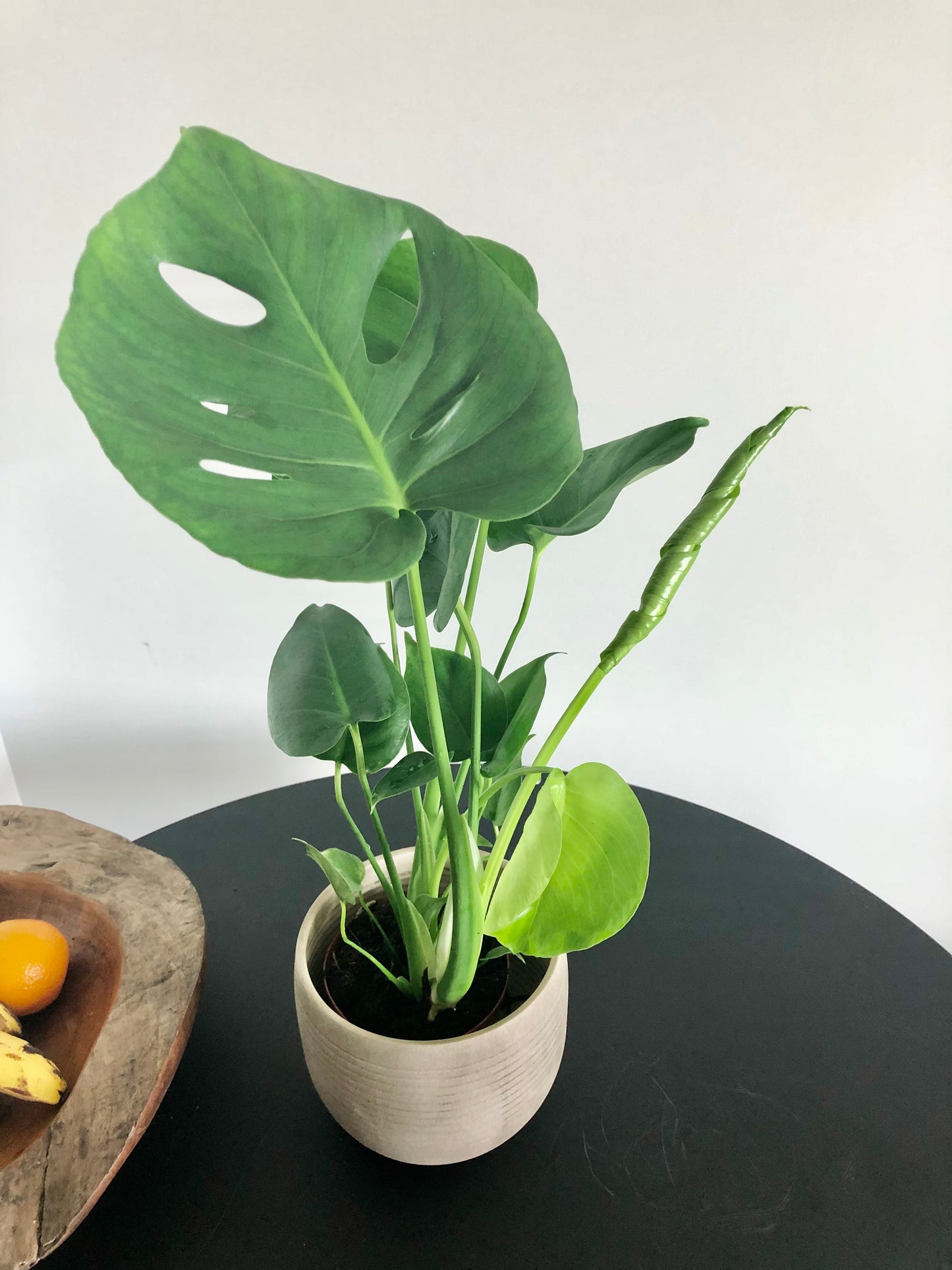How to Care for Your Swiss Cheese Plant (Monstera deliciosa)
The Monstera Deliciosa "Swiss Cheese" plant is a stunning, easy-to-care-for houseplant known for its distinctive, hole-punched leaves. Whether you’re a seasoned plant parent or a newcomer to indoor gardening, this beautiful plant can thrive with a bit of attention. Here's everything you need to know about caring for your Monstera Deliciosa.
General Care
Monstera Deliciosa Swiss Cheese plants are relatively low-maintenance, but they do require the right balance of light, water, and humidity to truly thrive. They grow quickly and can eventually reach quite large sizes, making them perfect for adding a tropical vibe to your home.
- Soil: Well-draining, aerated soil is essential. A mix designed for tropical plants or a peat-based potting soil with added perlite works well.
- Potting: Ensure your pot has drainage holes to prevent water from accumulating at the bottom, which can lead to root rot.
- Humidity: Monstera plants thrive in higher humidity (50-60% or more). If your home is dry, especially in the winter, you may want to use a humidifier or place a tray of water near the plant.
- Temperature: Keep your Monstera in a warm environment, ideally between 65-85°F (18-29°C). They don't like cold drafts or temperatures below 50°F (10°C).
Lighting
Monstera Deliciosa thrives in bright, indirect light, but can adapt to a range of lighting conditions. Direct sunlight can scorch their delicate leaves, while too little light will slow their growth.
- Bright, Indirect Light: Ideally, place your Monstera near a window with filtered sunlight (e.g., behind a sheer curtain or in a well-lit room).
- Low Light: While the plant can survive in lower light, it will grow slower and may not produce the iconic holes in its leaves. If your Monstera isn't getting enough light, you might notice it becoming leggy or its leaves becoming smaller.
- Avoid Direct Sun: Monstera Deliciosa Swiss Cheese plants can tolerate some morning or evening sunlight, but too much direct midday sun can lead to leaf burn, which appears as brown spots or edges.
Watering
Monstera plants are somewhat drought-tolerant, but they prefer to be watered regularly with a thorough soak when the soil begins to dry out.
- When to Water: Water your plant when the top 1–2 inches (2.5–5 cm) of soil feel dry to the touch. Avoid overwatering as this can lead to root rot.
- Watering Technique: Water thoroughly until water starts to drain out of the bottom of the pot. Make sure the excess water doesn't collect in the saucer.
- Frequency: The frequency of watering will depend on the temperature and humidity in your home. In general, water once every 7-10 days during the growing season (spring and summer) and less frequently in winter when the plant is dormant.
- Signs of Overwatering: Yellowing leaves, moldy or soggy soil, foul-smelling soil.
- Signs of Underwatering: Dry, crispy leaf edges, wilting, but soil may still be dry.
Fertilizing
While Monstera plants don’t need heavy feeding, providing them with a boost of nutrients can encourage faster growth and larger leaves.
- Type: Use a balanced, water-soluble fertilizer (e.g., 10-10-10) diluted to half strength.
- How Often: Fertilize every 4-6 weeks during the growing season (spring and summer). During fall and winter, the plant's growth slows, so you can reduce or stop fertilizing entirely.
- Organic Options: Alternatively, you can use organic fertilizers like fish emulsion or compost tea, which are gentler and provide a steady release of nutrients.
Pruning and Training
As your Monstera grows, it may need some shaping to keep it looking tidy. Regular pruning will also encourage new growth and keep your plant manageable.
- Pruning: Trim any dead or yellowing leaves with clean, sharp scissors. To prevent your Monstera from becoming too leggy, cut back any long vines that don’t seem to be producing new growth. You can propagate the cuttings in water or soil to grow new plants.
- Supporting Growth: Swiss Cheese Monsteras are natural climbers, so providing a moss pole or trellis can help support their upward growth. This encourages larger, healthier leaves and mimics their natural habitat.
Propagation
Monstera Deliciosa is easy to propagate, allowing you to create new plants from cuttings.
- Choose a Healthy Stem: Look for a cutting that has at least one leaf and a node (a small bump on the stem where roots and new growth can develop).
- Cut the Stem: Use a sharp, clean knife or scissors to take the cutting.
- Rooting: Place the cutting in water or directly into moist soil. If rooting in water, change the water every few days.
- Planting: Once roots are about 1-2 inches long, plant the cutting into a small pot with well-draining soil. Keep it in a warm, bright location with indirect light to encourage growth.
Common Issues and Troubleshooting
- Yellow Leaves: Overwatering is the most common cause, but it can also be due to poor drainage or nutrient deficiency.
- Brown Leaf Edges: This could be a sign of underwatering, low humidity, or exposure to direct sunlight.
- Pests: While relatively pest-resistant, Monstera plants can occasionally suffer from spider mites, aphids, or scale. Inspect your plant regularly for any signs of infestation, and treat with insecticidal soap or neem oil if necessary.
Conclusion
With the right care, your Monstera Deliciosa Swiss Cheese plant can become a striking centerpiece in your home. By ensuring proper light, water, humidity, and the occasional trim, you’ll help it thrive and grow to its full potential. Whether you’re adding it to a living room, office, or kitchen, this plant is a wonderful choice for both seasoned gardeners and beginners alike. Enjoy watching your Monstera flourish and become a true statement piece in your space!






